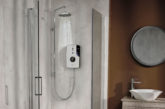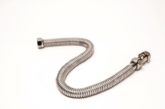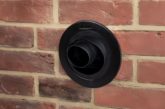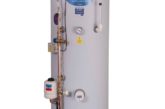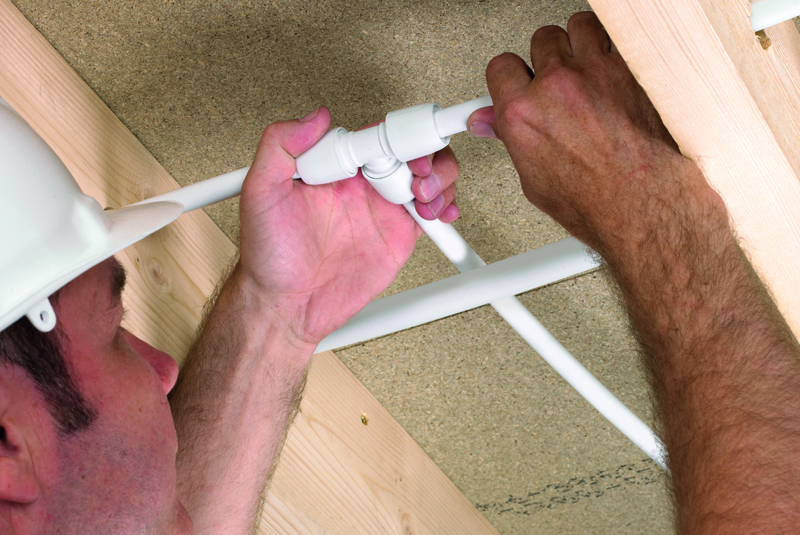
While push-fit systems have grown in popularity since the method was first developed in the 1970s, there continues to be a range of misconceptions around their use. Steve Harris, Technical Services Engineer for Hep2O at Wavin, dispels some of those most common myths.
Myth 1: Plastic is never as good as copper
Copper is part of the life of every plumber, but there are many situations where plastic can save time and make the job easier and more effective. In situations such as working in confined spaces, floor spaces, in the joists and areas such as lofts where hot works can be dangerous, push fit is an ideal solution.
A question often asked by those who don’t yet use Hep2O is what benefits it offers over copper. Speed of installation is perhaps the most obvious bonus. For example, Hep2O doesn’t require the use of any additional tools to complete an installation. Once the pipe has been measured and cut to length, installers simply connect it to the fitting meaning installation is quick and easy. Flexible pipe is easy to work with and often means fewer fittings are required, saving money on the total installation.
In addition, plastic push-fit is also safer to work with. There’s no need for soldering and therefore no risk of fire – a key benefit as health and safety requirements become ever more stringent.
As well as ease of fitting, flexibility and increased safety, Hep2O is also resistant to scale build up in hard water areas. What’s more, you can also use Hep2O in soft water areas, as no matter how acidic the water is, it won’t corrode the pipe.
Myth 2: You have to use copper with copper and plastic with plastic
Following on from the previous myth, it isn’t always a question of plastic push-fit or copper – they can work together.
Hep2O is made using polybutylene plastic, and has been designed to be compatible with other common materials used in plumbing and heating systems. It’s fully compatible with copper products without any extra equipment, and goes straight into the fitting using the same push-fit connection.
Similarly, if you’re fitting a central heating system, Hep2O pipes and fittings can be easily connected to existing copper systems. Straight connectors can go directly onto metric size copper pipe of the same diameter, as if they are the same material. And for or older imperial copper systems, adaptors are available.
Myth 3: All push-fit systems are the same
Push-fit systems are not all born equal and one of the things we have worked hard to make easier is in ensuring that the pipe is fully inserted into the fitting. All Hep2O fittings feature technology known as In4Sure, which means installers can ‘feel’ when the pipe is fully inserted into the fitting, thanks to a distinct ‘rumble’ sensation.
Installers can also visually inspect the fitting by checking the ‘^’ symbol is level with the end of the fitting. It’s handy all the time, but particularly useful when fitting into tight spaces.
That’s just one feature of Hep2O. Others include the HepKey, a specially-designed demounting tool that ensures pipes cannot be unintentionally disconnected from fittings.
Myth 4: You can use plastic push-fit systems on a hot return
Okay, now for a myth about something that push-fit isn’t actually the most suitable option for. No, plastic push-fit should not be fitted on a hot return.
Essentially, a hot return is water that’s in the second circulation. This means there will be oxygen and a slight trace of chlorine in the water. When that water is heated up it is agitated and the molecules become very aggressive. These aggressive molecules will attack the plastic pipe over a length of time. So, we therefore do not recommend using it for second circulation.
Press-fit systems such as Wavin’s Tigris are more suitable in such situations. The aluminium material between the inner and outer plastic layers reduces thermal expansion and acts as an oxygen diffusion barrier. These systems can withstand higher temperatures than other systems and are a popular choice for recirculating systems.
You can use push-fit on normal heating because the water that’s in radiators has been chemically treated. Also, the water is older so the molecules that can become agitated will have become depleted.
Myth 5: You can’t use push-fit and press-fit together
That’s certainly not true and, in fact, by integrating both push and press fit fittings installers can, in certain circumstances, create systems with more efficiency than ever before.
For example, in projects involving high-rise apartments, push and press-fit fittings can be used in conjunction. Installers can use push-fit fittings for the self-contained, individual apartments within the building, while opting for press-fit fittings to provide the plumbing infrastructure in the building. There is a transition fitting available from Hep2O to Wavin’s Tigris K1 systems, making the process simple – and using a full system from one manufacturer ensures the entire solution is guaranteed.
Myth 6: Hep2O cannot be demounted
It’s certainly true that Hep2O’s secure jointing system means that an installation is tamper proof and cannot be accidentally demounted by other trades or the homeowner. When you finish your job, you can be sure that it will stay as you left it.
However, the system is fully demountable by professional installers with a HepKey. The key comes in three variations. The standard version is the smallest and is fine for use in most applications. The HepKey Plus, meanwhile, clips over the pipe so it can be demounted with one hand. Where fittings are close together, or you need to demount a reducer fitting, there’s a metal Heptool.
Myth 7: You can’t use Hep2O underground
A common query put to us is whether screed has an effect on Hep2O. No, it doesn’t have any effect on the Polybutylene material, however water and building regulations require either a conduit or appropriate ducting to be used for hot and cold-water supplies which are to be buried in the screed.
It’s important to note the normal depth for Hep2O is a minimum of 600mm, so it wouldn’t withstand the weight of soil. However, Hep2O can be buried inside an insulated duct, so long as it is sealed at both ends. Treat the insulating pipe in the exact same way as a copper pipe and pad to the same thickness.








